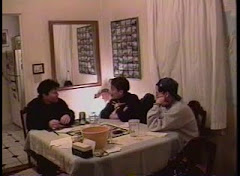Christina Higgins (Associate Professor, Second Language Studies, University of Hawaii)
An alum of English Language and Linguistics will be offering a lecture on
“Multilingual Swahili: Language play, double voices, and re-entextualization practices”
Wednesday, February 20, 2013
4:00-5:30
Room (206 Ingraham Hall)
Dr. Higgins is a highly productive, interdisciplinary scholar. Her work spans theoretical and methodological innovation as well as engaged and applied linguistic action. Here is how she describes herself on her website:
I am a sociolinguist who is interested in multilingual practices, globalization, and identity. In my research projects, I have drawn on discourse analytic, ethnographic, and qualitative approaches to study various facets of the global spread of English, Swahili variation, and multilingual identities. Geographically, I have focused much of my research on East Africa, where I have studied language in the workplace, the intersection of popular culture and multilingualism, and HIV/AIDS education sponsored by non-governmental organizations. Much of this work is synthesized in my recent book, English as a Local Language: Post-colonial Identities and Multilingual Practices (Multilingual Matters, 2009).
On December 1, 2009, Language and HIV/AIDS (co-edited with Bonny Norton, Multilingual Matters) became available. This edited volume focuses on the social and discursive construction of local and global knowledge in educational efforts meant to prevent the spread of HIV.
My research in Tanzania also includes a recent study on the development of intercultural identities among expatriate transnational Swahili speakers. The study is featured in my most recent book, Identity Formation in Globalizing Contexts (Mouton de Gruyter, 2011). This edited volume addresses identity construction among multilinguals in the context of new millennium globalization and includes studies from Tanzania, France, Hong Kong, England, Canada, and the United States.
I have also been exploring the sociolinguistics of multilingualism and language awareness in Hawai'i through various collaborative projects, including a videoethnographic project with high school students on the Leeward Coast of O'ahu (Higgins et al, forthcoming). Be sure to check out the documentary on youtube Ha Kam Wi Tawk Pidgin Yet? that the students produced when asked to explain why Pidgin is still spoken in Hawai'i, despite all the negative attitudes towards the language. This project includes a website with a Teacher's Guide and language awareness materials on Hawai'i Creole for high school language arts and social studies classrooms. Also see Da Pidgin Toolkit, a short claymation film that teaches newcomers to Hawai'i essential Pidgin vocabulary (e.g., da kine, ono, choke) in a creative way. To explain more about the history and development of Pidgin, I produced Pidgin: How was . . . how stay at the Hawai'i Plantation Village Museum in Waipahu, on the island of O'ahu. This is a permanent exhibit that explains how Pidgin came about on plantations and that documents the importance of the language to Hawaii's past and present.
I teach graduate level courses in sociolinguistics, discourse analysis, English and globalization, intercultural communication, and qualitative research methodology.He
I am a sociolinguist who is interested in multilingual practices, globalization, and identity. In my research projects, I have drawn on discourse analytic, ethnographic, and qualitative approaches to study various facets of the global spread of English, Swahili variation, and multilingual identities. Geographically, I have focused much of my research on East Africa, where I have studied language in the workplace, the intersection of popular culture and multilingualism, and HIV/AIDS education sponsored by non-governmental organizations. Much of this work is synthesized in my recent book, English as a Local Language: Post-colonial Identities and Multilingual Practices (Multilingual Matters, 2009).
On December 1, 2009, Language and HIV/AIDS (co-edited with Bonny Norton, Multilingual Matters) became available. This edited volume focuses on the social and discursive construction of local and global knowledge in educational efforts meant to prevent the spread of HIV.
My research in Tanzania also includes a recent study on the development of intercultural identities among expatriate transnational Swahili speakers. The study is featured in my most recent book, Identity Formation in Globalizing Contexts (Mouton de Gruyter, 2011). This edited volume addresses identity construction among multilinguals in the context of new millennium globalization and includes studies from Tanzania, France, Hong Kong, England, Canada, and the United States.
I have also been exploring the sociolinguistics of multilingualism and language awareness in Hawai'i through various collaborative projects, including a videoethnographic project with high school students on the Leeward Coast of O'ahu (Higgins et al, forthcoming). Be sure to check out the documentary on youtube Ha Kam Wi Tawk Pidgin Yet? that the students produced when asked to explain why Pidgin is still spoken in Hawai'i, despite all the negative attitudes towards the language. This project includes a website with a Teacher's Guide and language awareness materials on Hawai'i Creole for high school language arts and social studies classrooms. Also see Da Pidgin Toolkit, a short claymation film that teaches newcomers to Hawai'i essential Pidgin vocabulary (e.g., da kine, ono, choke) in a creative way. To explain more about the history and development of Pidgin, I produced Pidgin: How was . . . how stay at the Hawai'i Plantation Village Museum in Waipahu, on the island of O'ahu. This is a permanent exhibit that explains how Pidgin came about on plantations and that documents the importance of the language to Hawaii's past and present.
I teach graduate level courses in sociolinguistics, discourse analysis, English and globalization, intercultural communication, and qualitative research methodology.He

No comments:
Post a Comment